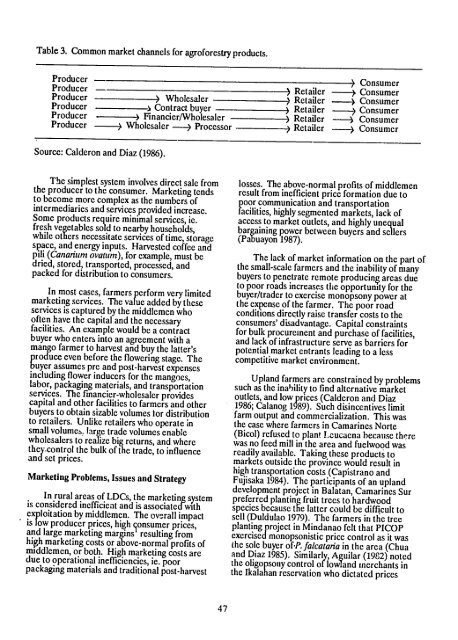multipurpose tree species research for small farms: strategies ... - part
multipurpose tree species research for small farms: strategies ... - part
multipurpose tree species research for small farms: strategies ... - part
Create successful ePaper yourself
Turn your PDF publications into a flip-book with our unique Google optimized e-Paper software.
Table 3. Common market channels <strong>for</strong> agro<strong>for</strong>estry products.<br />
Producer<br />
Producer -<br />
Producer ) Wholesaler<br />
Producer - 1 Contract buyer<br />
Producer - Financier/Wholesaler<br />
Producer - Wholesaler - Processor<br />
Source: Calderon and Diaz (1986).<br />
The simplest system involves direct sale from<br />
the producer to the consumer. Marketing tends<br />
to become more complex as the numbers of<br />
intermediaries and services provided increase.<br />
Some products require minimal services, ie.<br />
fresh vegetables sold to nearby households,<br />
while others necessitate services of time, storage<br />
space, and energy inputs. Harvested coffee and<br />
pili (Canarium ovatum), <strong>for</strong> example, must be<br />
dried, stored, transported, processed, and<br />
packed <strong>for</strong> distribution to consumers.<br />
In most cases, farmers per<strong>for</strong>m very limited<br />
marketing services. The value added by these<br />
services is captured by the middlemen who<br />
often have the capital and the necessary<br />
facilities. An example would be a contract<br />
buyer who enters into an agreement with a<br />
mango farmer to harvest and buy the latter's<br />
droduce even be<strong>for</strong>e the flowering stage. The<br />
ouyer assumes pre and post-harvest expenses<br />
including flower inducers <strong>for</strong> the mangoes,<br />
labor, packaging materials, and transportation<br />
services. The financier-wholesaler provides<br />
capital and other facilities to farmers and other<br />
buyers to obtain sizable volumes <strong>for</strong> distribution<br />
to retailers. Unlike retailers who operate in<br />
<strong>small</strong> volumes, large trade volumes enable<br />
wholesalers to realize big returns, and where<br />
theycontrol the bulk of the trade, to influence<br />
and set prices.<br />
Marketing Problems, Issues and Strategy<br />
In rural areas of LDCs, the marketing system<br />
is considered inefficicat and is associated wth<br />
exploitation by middlemen. The overall impact<br />
is low producer prices, high jonsumer prices,<br />
and large marketing margins resulting from<br />
high marketing costs or above-normal profits of<br />
middlemen, or both. High marketing costs are<br />
due to operational inefficiencies, ie. poor<br />
packaging materials and traditional post-harvest<br />
47<br />
) Consumer<br />
Retailer - . Consumer<br />
) Retailer - Consumer<br />
) Retailer - Consumer<br />
- Retailer - Consumer<br />
- Retailer - ) Consumer<br />
losses. The above-normal profits of middlemen<br />
result from inefficient price <strong>for</strong>mation due to<br />
foor communication and transportation<br />
acilities, highly segmented markets, lack of<br />
access to market outlets, and highly unequal<br />
bargaining power between buyers and sellers<br />
(Pabuayon 1987).<br />
The lack of market in<strong>for</strong>mation on the <strong>part</strong> of<br />
the <strong>small</strong>-scale farmers and the inability of many<br />
buyers to penetrate remote producin areas due<br />
to poor roads increases the opportunity <strong>for</strong> the<br />
buyer/trader to exercise monopsony power at<br />
the expense of the farmer. The poor road<br />
conditions directly raise transfer costs to the<br />
consumers' disadvantage. Capital constraints<br />
<strong>for</strong> bulk procurement and purchase of facilities,<br />
and lack of infrastructure serve as barriers <strong>for</strong><br />
potential market entrants leading to a less<br />
competitive market environment.<br />
Upland farmers are constrained by problems<br />
such as the inability to find alternative market<br />
outlets, and low prices (Calderon and Diaz<br />
1986; Calanog 1989). Such disincentives limit<br />
farm output and commercialization. This was<br />
the case where farmers in Camarines Norte<br />
(Bicol) refused to plant Leucaena because there<br />
was no feed mill in the area and fuelwood was<br />
readily available. Taking these products to<br />
markets outside the province would result in<br />
high transportation costs (Capistrano and<br />
Fujisaka 1984). The <strong>part</strong>icipants of an upland<br />
development project in Balatan, Camarines Sur<br />
preferred planting fruit <strong>tree</strong>s to hardwood<br />
<strong>species</strong> because the latter could be difficult to<br />
sell (Duldulao 1979). The farmers in thie <strong>tree</strong><br />
planting project in Mindanao felt that PICOP<br />
exercise monopsonistic price control as it was<br />
the sole buyer of.P. falcataria in the area (Chua<br />
and Diaz 1985). Similarly, Aguilar (1982) noted<br />
the oligopsony control oflowland merchants in<br />
the Ikalahan reservation who dictated prices

















